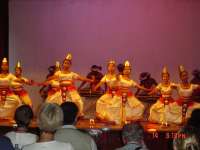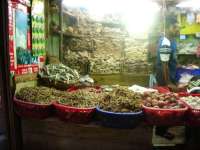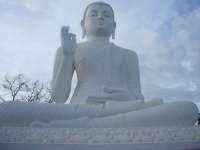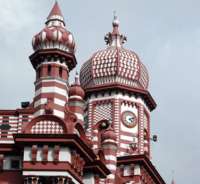Sri-Lankan Culture
Friendly, educated and hospitable are the characters of the people of Sri Lanka
The ancient Yaksha and Naga tribes Civilized before 300 B.C. using agriculture and irrigation, believed in Buddhism in early 2nd Century B.C. and also influenced by Indian invasions and going through Portuguese, Dutch and British rule, Sri Lankan Culture is diverse like it's Natural Heritage.
Srilankans are known as the Smiling People though out the world Sri Lankans enjoy a unique life style that's humble, artistic, entertaining & touching. The intimate connection between Society and Buddhism as well as traditional forms of Art, Dance and Music are the fusion of the Sri Lanka Culture
In the early 19th century The British rule introduced democracy, modern education, legal and commercial agriculture system. Sri Lanka now is a mirror of it's own ancient and modern cultures diverse from it's cities to far villages across the tiny island.
Today Social Diversity of Sri Lankans can be explained as people involved in software engineering International markets as well as traditional farmers using baffolas for to work in the paddy fields.
Demographics
 Sri
Lanka is the 53rd most populated nation in the world, with an annual population
growth rate of 0.79%. Sri Lanka has a birth rate of 15.63 births per 1,000
people and a death rate of 6.49 deaths per 1,000 people. Population density is
the greatest in western Sri Lanka, especially in and around Colombo. There is a
small population on the island of the Wanniyala-Aetto people, also known as
Veddahs. These are believed to be the oldest and indigenous ethnic group to
inhabit the island. The Sinhalese people form the largest ethnic group in the
nation, composing approximately 81.9% of the total population. Tamils are
concentrated in the North, East, Central and Western provinces of the country.
Sri
Lanka is the 53rd most populated nation in the world, with an annual population
growth rate of 0.79%. Sri Lanka has a birth rate of 15.63 births per 1,000
people and a death rate of 6.49 deaths per 1,000 people. Population density is
the greatest in western Sri Lanka, especially in and around Colombo. There is a
small population on the island of the Wanniyala-Aetto people, also known as
Veddahs. These are believed to be the oldest and indigenous ethnic group to
inhabit the island. The Sinhalese people form the largest ethnic group in the
nation, composing approximately 81.9% of the total population. Tamils are
concentrated in the North, East, Central and Western provinces of the country.
Tamils who were brought as indentured labourers from India by British colonists to work on estate plantations, nearly 50% of whom were repatriated following independence in 1948, are called "Indian Origin" Tamils. They are distinguished from the native Tamil population that has resided in Sri Lanka since ancient times. According to 2001 census data Indian Tamils makeup 5.1% of the Sri Lankan population and, Sri Lankan Tamils 4.3%.
There is a significant population (8.0%) of Moors in Sri Lanka, who trace their lineage to Arab traders and immigrants from the Middle East. Their presence is concentrated in the cities and the central and eastern provinces. There are also small ethnic groups such as the Burghers (of mixed European descent) and Malays from Southeast Asia.
 Sinhalese and Tamil are the two official languages of
Sri Lanka. English is spoken by approximately 10% of the population, and is
widely used for education, scientific and commercial purposes. Members of the
Burgher community speak variant forms of Portuguese Creole and Dutch with
varying proficiency, while members of the Malay community speak a form of creole
Malay that is unique to the island. Sri Lanka also enjoys significant religious
diversity. Approximately 69% of Sri Lankans are adherents of Buddhism.
Sinhalese and Tamil are the two official languages of
Sri Lanka. English is spoken by approximately 10% of the population, and is
widely used for education, scientific and commercial purposes. Members of the
Burgher community speak variant forms of Portuguese Creole and Dutch with
varying proficiency, while members of the Malay community speak a form of creole
Malay that is unique to the island. Sri Lanka also enjoys significant religious
diversity. Approximately 69% of Sri Lankans are adherents of Buddhism.
Theravada Buddhism is the predominant school, with distinctive sects such as Ramanna Nikaya, Amarapura Nikaya and Siam Nikaya being widely followed. Buddhism in Sri Lanka has been deeply influenced by indigenous faiths and traditions, as well as the influences of prevailing Buddhist schools in South East Asia. The ancient and famous Sri Dalada Maligawa or "Temple of the Tooth" is the principal Buddhist Temple in Sri Lanka, and by tradition houses the Tooth of Buddha. It is visited every year by millions of pilgrims. There are many other famous religious institutions in Sri Lanka that attract many visitors daily. Hinduism is practiced by 7.9% of the population, mainly from the Tamil community. Christianity is practiced by 7% of the population, especially by Burgher people though most Christians are Sinhalese or Tamils. While most Sri Lankan Christians are Catholics, there are also significant numbers who adhere to Dutch Reformed Church and the Anglican Communion. Islam in Sri Lanka is practiced by 8.5% of the population and its adherents are almost entirely Moors and Malays.
Sri Lanka Culture and arts
Hoppers, a Sri Lankan delicacy.Main article: Culture of Sri Lanka
The island is the home of two main traditional cultures: the Sinhalese (centered
in the ancient cities of Kandy and Anuradhapura) and the Tamil (centered in the
city of Jaffna). In more recent times a British colonial culture was added, and
lately Sri Lanka, particularly in the urban areas, has experienced a dramatic
makeover in the western mold. Until recently, for example, most Sri Lankans,
certainly those in the villages, have eaten traditional food, engaged in
traditional crafts and expressed themselves through traditional arts. But
economic growth and intense economic competition in developed countries has
spilled over to most of Sri Lanka, producing changes that might variously be
identified as progress, westernisation or a loss of identity and assimilation.
Sri Lanka Traditional food
 kavadi
by Hindu Devotess at Vavuniya
kavadi
by Hindu Devotess at Vavuniya
Elephants at the Esala Perahera.Sri Lankans have added western influences to the
customary diet such as rice and curry, pittu (mixture of fresh rice meal, very
lightly roasted and mixed with fresh grated coconut, then steamed in a bamboo
mould). Kiribath (cooked in thick coconut cream for this unsweetened
rice-pudding which is accompanied by a sharp chili relish called "lunumiris"),
wattalapam (rich pudding of Malay origin made of coconut milk, jaggery, cashew
nuts, eggs, and various spices including cinnamon cloves and nutmeg), kottu, and
hoppers ("appa"), batter cooked rapidly in a hot curved pan, accompanied by
eggs, milk or savouries. Sri Lankan food also has Dutch and Portuguese
influences, with the island's Burgher community preserving this culture through
traditional favourites such as Lamprais (rice cooked in stock and baked in a
banana leaf), Breudher (Dutch Christmas cake) and Bolo Fiado (Portuguese-style
layer cake).
Sri Lanka Festivals
Sinhala and Tamil New Year Festival Every year on April 13th Sinhala and Tamil people celebrate, and Muslims celebrate Ramasan. Esala Perahera (A-suh-luh peh-ruh-ha-ruh) is the grand festival of Esala held in Sri Lanka. It is very grand with elegant costumes. Happening in July or August in Kandy, it has become a unique symbol of Sri Lanka. It is a Buddhist festival consisting of dances and richly-decorated elephants. There are fire-dances, whip-dances, Kandian dances and various other cultural dances. The elephants are usually adorned with lavish garments. The festival ends with the traditional 'diya-kepeema'. The elephant is paraded around the city bearing the tooth of Buddha.
Sri Lanka Cinema
Kadawunu Poronduwa 1947 Sri Lankan cinema in past years has featured subjects such as family relationships, love stories and the years of conflict between the military and Tamil Tiger rebels. Many films are in the Sinhalese language and the Sri Lankan cinematic style is similar to Indian cinema.
The first film to be produced and shown in Sri Lanka was Kadawunu Poronduwa (The Broken Promise) which was released in 1947. The first colour film of Sri Lanka was Ran Muthu Doova.
Afterwards there were many Sinhalese movies produced in Sri Lanka and some of them, such as Nidhanaya, received several international film awards. The most influential filmmaker in the history of Sri Lankan cinema is Lester James Peiris who has directed many movies of excellent quality which led to global acclaim. His latest film, 'Wekanda Walawwa' (Mansion by the Lake) became the first movie to be submitted from Sri Lanka for the Best Foreign Language film award at the Academy Awards. In 2005 the director Vimukthi Jayasundara became the first Sri Lankan to win the prestigious Camera d?Or award for Best First Film, or any award for that matter, at the Cannes Film Festival for his Sinhalese language film Sulanga Enu Pinisa (The Forsaken Land).
Controversial filmmaker Asoka Handagama's films are considered by many in the Sri Lankan film world to be the best films of honest response to the ethnic conflict currently raging in the country. Prasanna Vithanage is one of Sri Lanka's most notable filmmakers. His films have won many awards, both local and international. Recent releases like 'Sooriya Arana', 'Samanala thatu', and 'Hiripoda wessa' have attracted Sri Lankans to cinemas. Sri Lankan films are usually in the Sinhalese language. Tamil language movies are also filmed in Sri Lanka but they are not part of Kollywood which is Indian Tamil cinema. However some Kollywood films are based in Sri Lanka as well.
Music
The earliest music came from the theater at a time when the traditional open-air drama (referred to in Sinhala as Kolam, Sokari and Nadagam). In 1903 the first music album, Nurthi, was released through Radio Ceylon. Also Vernon Corea introduced Sri Lankan music in the English Service of Radio Ceylon.
In the early 1960s, Indian music in films greatly influenced Sri Lankan music and later Sri Lankan stars like Sunil Shantha found greater popularity among Indian people. By 1963, Radio Ceylon had more Indian listeners than Sri Lankan ones. The notable songwriters Mahagama Sekara and Ananda Samarakoon made a Sri Lankan music revolution. At the peak of this revolution, musicians such as W. D. Amaradeva, H.R. Jothipala, Milton Mallawarachchi, M.S. Fernando, Annesley Malewana and Clarence Wijewardene did great work.
See also: Ceylon tea (black), Cuisine of Sri Lanka, Fashion Industry of Sri Lanka, Kandyan Dance, Cinema of Sri Lanka, and Music of Sri Lanka
Religions
 Buddhism
is followed by over 70% of the population
Buddhism
is followed by over 70% of the population
The Nallur Kandaswamy Kovil, Jaffna is an important place for Hindus in Sri
LankaMain article: Religion in Sri Lanka
Sri Lanka has a multi ethnic and multi religious population. Buddhism
constitutes the religious faith of about 70% of the population of the
island,[29] most of whom follow the Theravada school of Buddhism.[30] According
to traditional Sri Lankan chronicles, Buddhism was introduced into Sri Lanka in
the 2nd century BCE by Venerable Mahinda, the son of the Emperor Ashoka, during
the reign of Sri Lanka's King Devanampiyatissa.[30] During this time, a sapling
of the Bodhi Tree under which the Buddha attained enlightenment was brought to
Sri Lanka and the first monasteries were established under the sponsorship of
the Sri Lankan king. The Pali Canon (Thripitakaya), having previously been
preserved as an oral tradition, was first committed to writing in Sri Lanka
around 30 BC.
Sri Lanka has the longest continuous history of Buddhism of any Buddhist nation,[30] with the Sangha having existed in a largely unbroken lineage since its introduction in the 2nd century BCE. During periods of decline, the Sri Lankan monastic lineage was revived through contact with Thailand and Burma.[31] Periods of Mahayana influence, as well as official neglect under colonial rule, created great challenges for Theravada Buddhist institutions in Sri Lanka, but repeated revivals and resurgences ? most recently in the 19th century ? have kept the Theravada tradition alive for over 2000 years.
 The
Jami Ul Alfar mosque in Colombo. Islam was brought to Sri Lanka by Arab
Merchants Followers of Islam comprise approximately eight percent of the
population,[29] having been brought to the island by Arab traders over the
course of many centuries.[32] Hinduism was primarily established in Sri Lanka by
migrants and often invaders from southern India,[33] and Hindus now constitute
seven percent of the population, mostly of the Shaivite school.[29] European
colonists introduced Christianity to the country in the 16th century,[34] and
the religion has been adopted by around six percent of the population.
The
Jami Ul Alfar mosque in Colombo. Islam was brought to Sri Lanka by Arab
Merchants Followers of Islam comprise approximately eight percent of the
population,[29] having been brought to the island by Arab traders over the
course of many centuries.[32] Hinduism was primarily established in Sri Lanka by
migrants and often invaders from southern India,[33] and Hindus now constitute
seven percent of the population, mostly of the Shaivite school.[29] European
colonists introduced Christianity to the country in the 16th century,[34] and
the religion has been adopted by around six percent of the population.
Religion plays an important part in the life and culture of Sri Lankans. The
Buddhist majority observe Poya Days, once per month according to the Lunar
calendar. The Hindus and Muslims also observe their own holidays. There are many
Buddhist temples in Sri Lanka and many mosques, Hindu temples and churches
across the island, especially in areas where respective communities are
concentrated. Buddhists are distributed across most parts of the island except
in the north. Hindus are concentrated in north, east, and central high lands.
Christians, particularly Roman Catholics are mainly concentrated along the
western coastal belt. Muslims are concentrated in several pockets along the
coast and in interior. All religious communities are represented in western
province and in other urban centers in sizable numbers.

